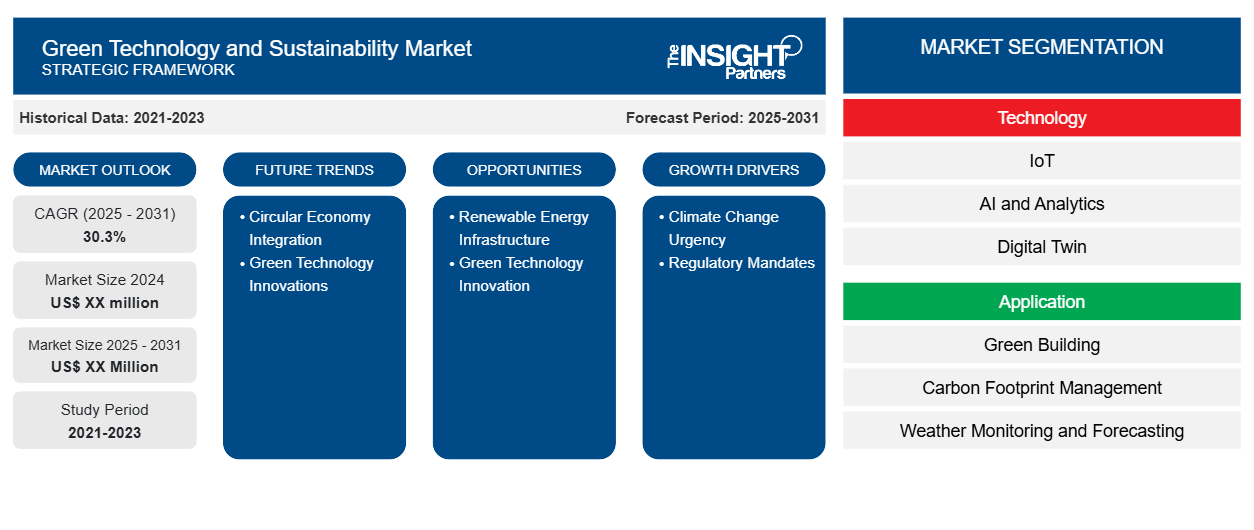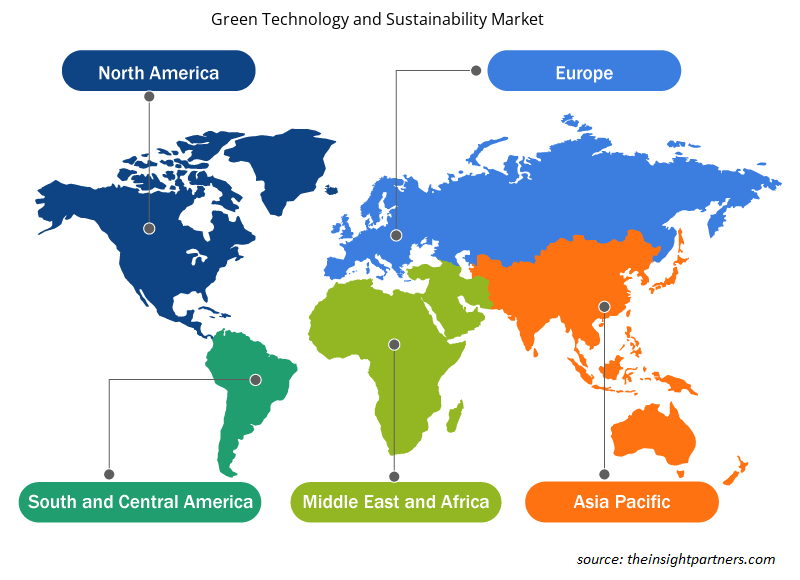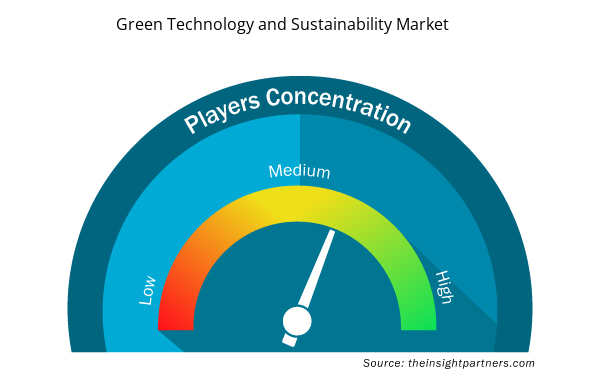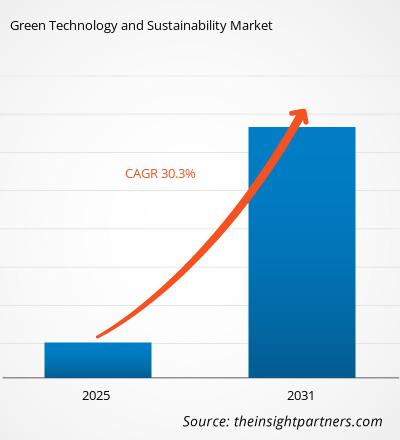The Green Technology and Sustainability Market is expected to register a CAGR of 30.3% from 2025 to 2031, with a market size expanding from US$ XX million in 2024 to US$ XX Million by 2031.
The report is segmented by Technology (IoT, AI and Analytics, Digital Twin, Cloud Computing, Security, Blockchain); Application (Green Building, Carbon Footprint Management, Weather Monitoring and Forecasting). The global analysis is further broken-down at regional level and major countries. The report offers the value in USD for the above analysis and segments
Purpose of the Report
The report Green Technology and Sustainability Market by The Insight Partners aims to describe the present landscape and future growth, top driving factors, challenges, and opportunities. This will provide insights to various business stakeholders, such as:
- Technology Providers/Manufacturers: To understand the evolving market dynamics and know the potential growth opportunities, enabling them to make informed strategic decisions.
- Investors: To conduct a comprehensive trend analysis regarding the market growth rate, market financial projections, and opportunities that exist across the value chain.
- Regulatory bodies: To regulate policies and police activities in the market with the aim of minimizing abuse, preserving investor trust and confidence, and upholding the integrity and stability of the market.
Green Technology and Sustainability Market Segmentation
Technology
- IoT
- AI and Analytics
- Digital Twin
- Cloud Computing
- Security
- Blockchain
Application
- Green Building
- Carbon Footprint Management
- Weather Monitoring and Forecasting
Customize This Report To Suit Your Requirement
You will get customization on any report - free of charge - including parts of this report, or country-level analysis, Excel Data pack, as well as avail great offers and discounts for start-ups & universities
Green Technology and Sustainability Market: Strategic Insights

- Get Top Key Market Trends of this report.This FREE sample will include data analysis, ranging from market trends to estimates and forecasts.
Green Technology and Sustainability Market Growth Drivers
- Climate Change Urgency: Increasing global temperatures, extreme weather events, and rising environmental consciousness are driving massive investments in green technologies. Governments and corporations are accelerating carbon reduction strategies, creating unprecedented momentum for sustainable solutions that mitigate climate change and reduce greenhouse gas emissions.
- Regulatory Mandates: Stringent environmental regulations and international climate agreements are compelling industries to adopt greener practices. Governments worldwide are implementing carbon pricing, emissions standards, and incentive programs that mandate sustainable technologies, pushing businesses to innovate and transform their operational models
Green Technology and Sustainability Market Future Trends
- Circular Economy Integration: The shift from linear "take-make-dispose" models to circular economy principles is transforming sustainability approaches. Companies are redesigning products for reuse, recycling, and minimal waste, creating regenerative systems that optimize resource utilization, reduce environmental impact, and generate economic value through innovative waste management strategies.
- Green Technology Innovations: Continuous advancements in green technologies, such as energy-efficient appliances, electric vehicles (EVs), smart cities, and carbon capture and storage (CCS), are spurring market growth. These innovations are making green technologies more accessible, affordable, and effective.
Green Technology and Sustainability Market Opportunities
- Renewable Energy Infrastructure: Massive potential exists in developing advanced renewable energy technologies, grid modernization, and energy storage solutions. Emerging markets present significant opportunities for solar, wind, and hydrogen infrastructure investments, with potential to revolutionize global energy systems and address growing electricity demands sustainably.
- Green Technology Innovation: Breakthrough technologies in areas like carbon capture, sustainable materials, electric mobility, and precision agriculture offer immense commercial potential. Entrepreneurs and researchers can develop scalable solutions that address critical environmental challenges while creating new economic opportunities across multiple sectors.
Green Technology and Sustainability Market Regional Insights
The regional trends and factors influencing the Green Technology and Sustainability Market throughout the forecast period have been thoroughly explained by the analysts at Insight Partners. This section also discusses Green Technology and Sustainability Market segments and geography across North America, Europe, Asia Pacific, Middle East and Africa, and South and Central America.

- Get the Regional Specific Data for Green Technology and Sustainability Market
Green Technology and Sustainability Market Report Scope
| Report Attribute | Details |
|---|---|
| Market size in 2024 | US$ XX million |
| Market Size by 2031 | US$ XX Million |
| Global CAGR (2025 - 2031) | 30.3% |
| Historical Data | 2021-2023 |
| Forecast period | 2025-2031 |
| Segments Covered |
By Technology
|
| Regions and Countries Covered | North America
|
| Market leaders and key company profiles |
Green Technology and Sustainability Market Players Density: Understanding Its Impact on Business Dynamics
The Green Technology and Sustainability Market market is growing rapidly, driven by increasing end-user demand due to factors such as evolving consumer preferences, technological advancements, and greater awareness of the product's benefits. As demand rises, businesses are expanding their offerings, innovating to meet consumer needs, and capitalizing on emerging trends, which further fuels market growth.
Market players density refers to the distribution of firms or companies operating within a particular market or industry. It indicates how many competitors (market players) are present in a given market space relative to its size or total market value.
Major Companies operating in the Green Technology and Sustainability Market are:
- ConsenSys Software Inc.
- Cority
- General Electric
- IBM
- LO3 Energy.
Disclaimer: The companies listed above are not ranked in any particular order.

- Get the Green Technology and Sustainability Market top key players overview
Key Selling Points
- Comprehensive Coverage: The report comprehensively covers the analysis of products, services, types, and end users of the Green Technology and Sustainability Market, providing a holistic landscape.
- Expert Analysis: The report is compiled based on the in-depth understanding of industry experts and analysts.
- Up-to-date Information: The report assures business relevance due to its coverage of recent information and data trends.
- Customization Options: This report can be customized to cater to specific client requirements and suit the business strategies aptly.
The research report on the Green Technology and Sustainability Market can, therefore, help spearhead the trail of decoding and understanding the industry scenario and growth prospects. Although there can be a few valid concerns, the overall benefits of this report tend to outweigh the disadvantages.
- Historical Analysis (2 Years), Base Year, Forecast (7 Years) with CAGR
- PEST and SWOT Analysis
- Market Size Value / Volume - Global, Regional, Country
- Industry and Competitive Landscape
- Excel Dataset



Report Coverage
Revenue forecast, Company Analysis, Industry landscape, Growth factors, and Trends

Segment Covered
This text is related
to segments covered.

Regional Scope
North America, Europe, Asia Pacific, Middle East & Africa, South & Central America

Country Scope
This text is related
to country scope.
Frequently Asked Questions
Some of the customization options available based on the request are an additional 3-5 company profiles and country-specific analysis of 3-5 countries of your choice. Customizations are to be requested/discussed before making final order confirmation# as our team would review the same and check the feasibility
The report can be delivered in PDF/PPT format; we can also share excel dataset based on the request
Circular economy integration is anticipated to play a significant role in the global green technology and sustainability market in the coming years.
Climate change urgency and regulatory mandates are the major factors driving the green technology and sustainability market
The Green Technology and Sustainability Market is estimated to witness a CAGR of 30.3% from 2023 to 2031
Trends and growth analysis reports related to Technology, Media and Telecommunications : READ MORE..
The List of Companies
- ConsenSys Software Inc.
- Cority
- General Electric
- IBM
- LO3 Energy.
- Microsoft
- Sensus, a Xylem brand.
- Taranis
- Trace Genomics, Inc.
- Wolters Kluwer N.V.

 Get Free Sample For
Get Free Sample For